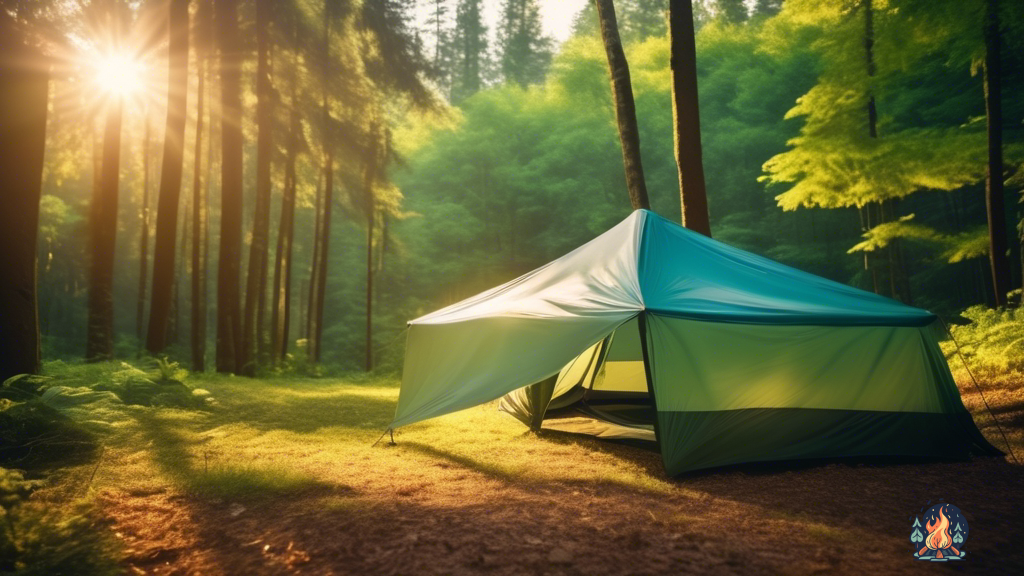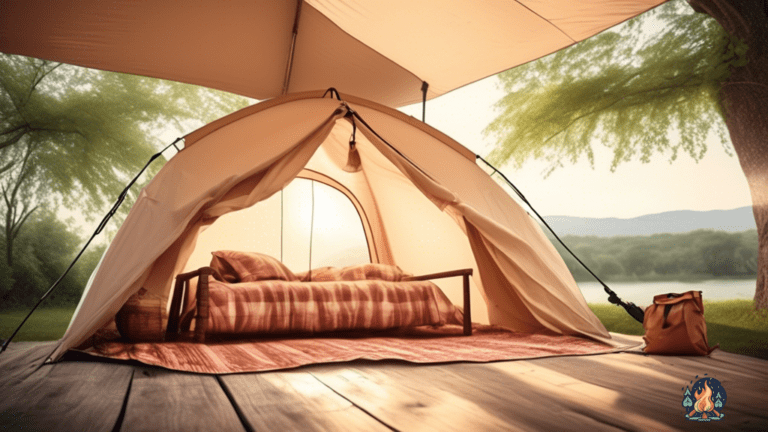Protect Your Campsite With A Camping Tarp
by Kevin Fairbanks • Updated: February 21, 2024
Enhance your camping experience with a durable camping tarp! Learn how to protect your campsite and stay dry in any weather conditions. Click now to discover the ultimate camping companion for your next outdoor adventure!

When you’re out in the great outdoors, the last thing you want is for your camping experience to be ruined by unexpected weather conditions.
That’s where a camping tarp comes in handy. By setting up a camping tarp properly, you can protect your campsite from rain, wind, and sun, allowing you to fully enjoy your time in nature without worrying about the elements.
Choosing the right size and material for your camping tarp is crucial to ensuring its effectiveness in protecting your campsite. With a variety of options available, from lightweight nylon tarps to heavy-duty canvas tarps, you can find the perfect tarp to suit your needs.
By learning how to properly set up and secure your camping tarp, you can create a safe and comfortable outdoor shelter that gives you the freedom to relax and explore without the fear of unpredictable weather conditions ruining your camping experience.
Key Takeaways
- Choosing the right size and material of the camping tarp is crucial for maximum protection
- Properly setting up the camping tarp is important to ensure it serves its purpose effectively
- Securing the camping tarp in windy conditions is necessary to prevent it from getting damaged
- Proper packing and storing of the camping tarp after use ensures its longevity and continued effectiveness
Choosing the Right Size and Material
When setting up your campsite, make sure to choose the right size and material for your camping tarp to ensure maximum protection against the elements. Opt for a tarp that’s slightly larger than your tent to provide adequate coverage and prevent any water from seeping through during rainstorms.
Additionally, consider the material of the tarp – a heavy-duty polyethylene tarp is durable and waterproof, perfect for protecting your gear and keeping your campsite dry.
As you explore the great outdoors, freedom is essential, and having the right camping tarp can give you the peace of mind to truly enjoy your adventure without worrying about the weather. Choose a tarp that suits your needs and preferences, whether it’s a lightweight option for backpacking or a heavy-duty tarp for extended camping trips.
With the right size and material, your camping tarp will be your reliable companion in creating a safe and comfortable outdoor haven.
Setting Up Your Camping Tarp Properly
By ensuring the tarp is securely fastened, you can create a protective barrier for your outdoor shelter.
Begin by finding sturdy trees or poles to anchor the corners of the tarp. Use strong ropes or bungee cords to tie them down securely, making sure there aren’t any loose ends flapping in the wind.
Adjust the tension of the tarp to ensure it’s taut and won’t sag under the weight of rain or snow. This setup not only protects you from the elements but also gives you a sense of security, knowing your campsite is well-guarded.
Once the tarp is in place, take a moment to admire your handiwork. Stand back and appreciate the simple beauty of your shelter, knowing that you’ve taken the necessary steps to protect yourself and your belongings.
As you relax under the tarp, listening to the sounds of nature around you, you can feel a sense of freedom and peace wash over you. Embrace the feeling of being one with the outdoors, knowing that you’ve created a safe haven in the midst of the wilderness.
Securing Your Tarp in Windy Conditions
To keep your setup secure in strong winds, make sure to anchor the tarp properly. When the wind starts to pick up, the last thing you want is for your tarp to come loose and fly away.
Here are four essential tips to help you secure your tarp in windy conditions:
- Use sturdy stakes: Make sure to use heavy-duty stakes to anchor your tarp securely to the ground.
- Tie down all corners: Double check that all corners of your tarp are securely tied down to prevent any flapping in the wind.
- Add extra guy lines: Consider adding extra guy lines to provide additional support and stability to your tarp structure.
- Check regularly: Keep an eye on your tarp throughout the day and adjust as needed to ensure it stays secure in changing wind conditions.
With these tips in mind, you can relax and enjoy the freedom of the outdoors without worrying about your campsite being disrupted by the wind. Stay prepared and keep your tarp secure for a stress-free camping experience.
Using Your Tarp for Multiple Purposes
Get creative with how you can use the versatile tarp to make your camping experience even better. Sure, you can use it as a shelter or ground cover, but why stop there?
Use it as a makeshift picnic blanket for a cozy outdoor meal, or create a shaded area for relaxation during the hot afternoon. Need a quick rain cover for your gear? The tarp has got you covered.
The possibilities are endless when you let your imagination run wild with how to utilize this simple yet powerful camping tool. Don’t limit yourself to just one use for your tarp; embrace its flexibility and adaptability to enhance your camping adventures.
Need a windbreak to shield your campfire? The tarp can do that. Want to create a privacy screen around your tent? The tarp is your solution.
Whether it’s for hanging out with friends, protecting your gear, or adding a touch of comfort to your campsite, the tarp is your go-to tool. So go ahead, explore the various ways you can use your tarp and make your camping experience even more enjoyable.
Properly Packing and Storing Your Camping Tarp
Properly packing and storing your camping tarp is like folding a giant origami puzzle. As you take down your temporary shelter, remember to shake off any dirt or debris before beginning the folding process.
Start by laying the tarp flat on the ground and then carefully fold it in half, lengthwise. Next, fold it in half again, making sure to smooth out any creases as you go.
Continue to fold the tarp in a methodical manner until you have a compact and tidy package that’s ready for storage.
Once your camping tarp is neatly folded, it’s time to find a suitable place to store it until your next adventure. Look for a dry and cool area where the tarp won’t be exposed to extreme temperatures or moisture.
Avoid storing it in direct sunlight, as this can cause the material to deteriorate over time. Consider investing in a storage bag or container to keep your tarp protected and organized.
By taking the time to properly pack and store your camping tarp, you’ll ensure that it remains in good condition for many camping trips to come.
Frequently Asked Questions
Can a camping tarp protect against wildlife such as bears or raccoons?
Yes, a camping tarp can provide a barrier against wildlife like bears or raccoons. It acts as a protective shield for your campsite, deterring curious critters from getting too close to your belongings.
Are there any specific safety precautions to consider when using a camping tarp in extreme weather conditions?
When facing extreme weather while camping, always secure your tarp tightly to prevent it from blowing away. Avoid setting up near trees or sharp objects that could damage the tarp. Stay safe out there!
How can I repair tears or holes in my camping tarp?
To repair tears or holes in your camping tarp, grab a patch kit with adhesive backing. Clean the area, apply the patch, and press firmly. Voila! Your tarp is good as new, ready for more adventures!
Can a camping tarp be used as a makeshift shelter during emergencies?
In emergencies, a camping tarp can serve as a makeshift shelter, providing protection against the elements. With its versatility and durability, it offers a quick solution for temporary housing when you need it most.
Are there any specific guidelines for disposing of a camping tarp responsibly when it reaches the end of its lifespan?
When it’s time to say goodbye to your camping tarp, remember to dispose of it responsibly. Check with local recycling centers or waste management facilities for proper disposal methods to keep the environment clean.

Hi, I’m Kevin, a lifelong camping enthusiast and the voice behind Campfire Discoveries. From tent to RV to cabin camping, I’ve explored it all. Join me as we share stories and tips around the campfire, deepening our connection with the great outdoors.
Keep Reading
-
Choosing The Right Camping Stove For Outdoor Cooking
Make outdoor cooking a breeze with the perfect camping stove. Learn how to choose the right one for your next adventure and start enjoying delicious meals in the great outdoors today!
-
Waterproof Tent Materials: What You Need To Know
Stay dry on your camping trips with the best waterproof tent materials. Learn what you need to know and never worry about rain again. Click now for the ultimate guide!
-
Sleep In Comfort With A Camping Inflatable Mattress
Experience ultimate comfort while camping with our inflatable mattress. Say goodbye to restless nights and hello to a peaceful sleep under the stars! Click now to learn more and upgrade your camping experience.



